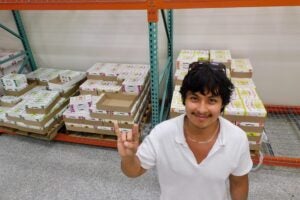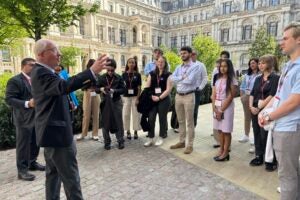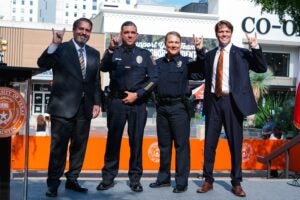Astronaut Karen Nyberg made history June 14 when the space shuttle Discovery landed at NASA’s Kennedy Space Center after completing a 14-day journey of more than 5.7 million miles in space.
The University of Texas at Austin graduate is the ninth Longhorn and 50th woman to go into space. She is also the first to operate three robotic arms in space.
Nyberg grew up in Minnesota and received her bachelor’s degree from the University of North Dakota before attending The University of Texas at Austin, where she earned a master of science degree in 1996 and a Ph.D. in 1998, both in mechanical engineering.
Nyberg said she knew from a young age that she wanted to be an astronaut and became known as the rocket scientist in high school where a friend wrote in her yearbook, “Have fun on the moon.”
“I just decided that that’s what I wanted to do and I kind of kept that with me and most of my friends in high school knew that’s what I wanted to do,” she said in a NASA interview.
Her research at the university was completed under the direction of Professor Kenneth Diller, chairman of the Department of Biomedical Engineering in the Cockrell School of Engineering.
Nyberg worked in the Bioheat Transfer Laboratory where she conducted testing related to the control of thermal neutrality in space suits.
“She was a highly motivated and hard-working student,” Diller said, noting that while at the university he saw Nyberg grow personally and professionally.
“When she was a student she progressed from being a very intelligent bachelor level graduate-trained engineer who wanted to become an astronaut to becoming an advanced expert in her own area and an innovative thinker,” Diller said. “When she graduated she was recognized as a person who had made a significant contribution to the space program and considered a real leader in her field.”
Diller always knew Nyberg’s ultimate goal was to travel into space and he was proud and happy for her when her dream came true.
“I was very happy for her but not surprised,” he said. “She has a lot of skill and it was obvious to me that she would be chosen sooner or later. One of the greatest joys of being a professor is working with graduate students and Karen was absolutely an outstanding graduate student.”
Nyberg flew on NASA’s STS-124 mission, the second of three flights to launch components to the International Space Station to complete the Japan Aerospace Exploration Agency’s Kibo laboratory.
She helped deliver Kibo’s tour bus-sized Japanese Pressurized Module, or JPM, which is the station’s largest module. The mission included three spacewalks to install and outfit the JPM and activate its robotic arm system.
Nyberg was one of four mission specialists on the eight-person crew. As a specialist she had the opportunity to operate all three robotic arms – the shuttle robotic arm, space station robotic arm and new Japanese robotic arm.
STS-124 was the 123rd space shuttle flight and the 35th flight for Discovery. The flight also made Nyberg the ninth Longhorn to travel into space.
Previous Longhorns in space have been Alan Bean (B.S.’55), Robert L. Crippen (B.S. ’60), Carl J. Meade (B.S. ’73), Michael A. Baker (B.S. ’75), Kenneth D. Cockrell (B.S. ’72), Paul S. Lockhart (M.S. ’81), Neil W. Woodward, III (M.A. ’88) and Stephanie D. Wilson (M.S. ’92). All are Cockrell School of Engineering graduates except Woodward who is a College of Natural Sciences alumnus.
“It is a great source of pride for the Cockrell School to produce eight astronauts,” said Ben Streetman, dean of the school. “That’s a large number and it speaks well of the program.”
Streetman noted that in addition to the astronauts a large number of graduates have gone on to work for NASA and play an important role in the space program.
“We have had an enormous impact on the space program.”



